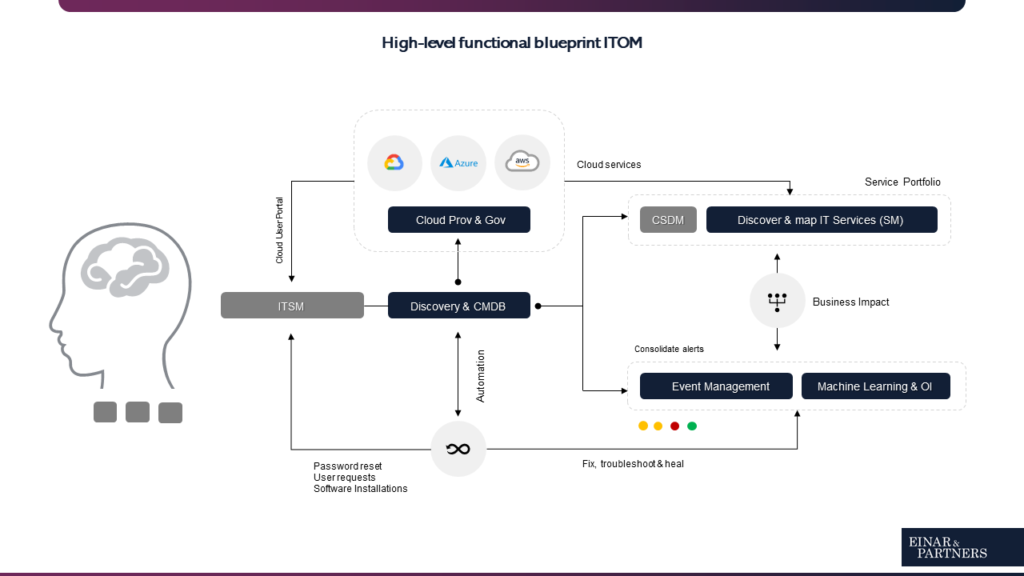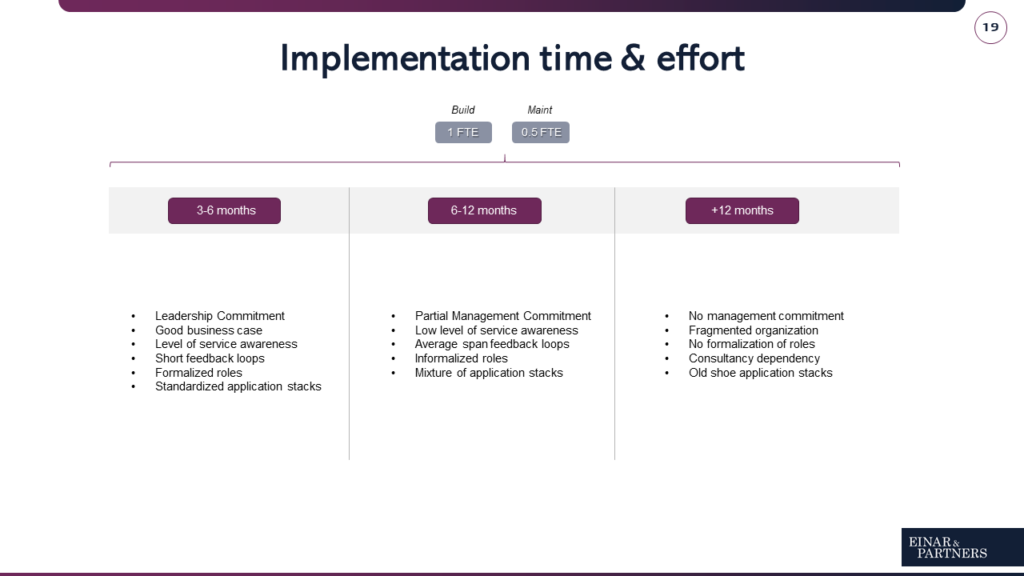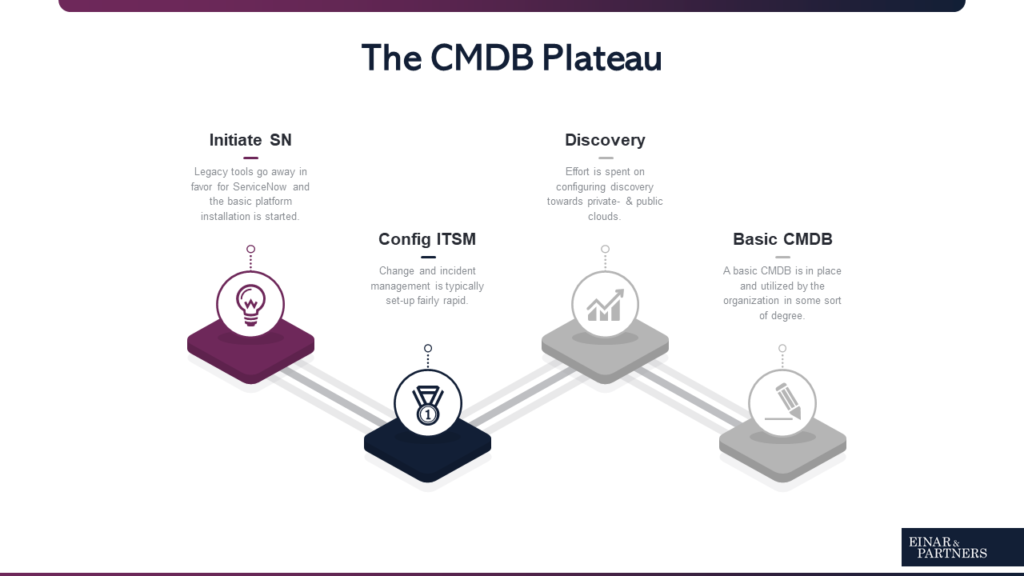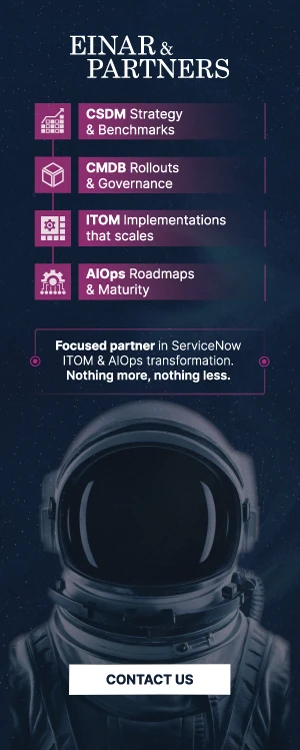What are the factors to consider when moving beyond discovery in ServiceNow ITOM? Many organizations that purchase ServiceNow find themselves stuck in moving beyond the basic CMDB and ITSM setup.
This article is an in-depth report by Einar & Partners on how to move away from stagnation to harvest the benefits of IT Operations Management.
Welcome to our deep-dive about creating the ultimate ServiceNow ITOM Roadmap after Discovery.
Before we get started – let’s define a roadmap
When approaching ITOM transformations in the industry, one will often find that a roadmap is drafted and created based on the available ServiceNow ITOM modules, or sometimes – the licensing model.
Such as ITOM Visibility, Health & Insights.
Although this approach is not wrong, we argue that it does not constitute a roadmap per se, but rather a module- or license ramp-up model.
In other words, a roadmap should not be driven by when functionality is enabled, but by the needs of the organization (and therein lies the priorities).
Ultimately the ITOM modules or licensing ramp-up should come as a result of a planned roadmap – not the other way around.
To give a practical example, think of the difference “In 6 months, IT should be doing automatic impact analysis” compared to “In 6 months we are going to activate licenses for Service Mapping“.
The former is the driver, the latter is the result.
Simplifying the ITOM portfolio
Perhaps you are a decision-maker who is planning for ServiceNow ITOM, or perhaps you are a consultant that finds yourself embarking on the ITOM journey advising a client. Regardless of your job or purpose for being interested in an ITOM roadmap – let’s try to first simplify the ITOM portfolio.
Have a look at the blueprint below. As you can see there are many modules to take into consideration (click on the images for larger size).

To make things simple, regardless of which modules we are interested in – the road we take after discovery can generally be categorized in one of two areas; Business- or IT Innovation.
In this article, we will cover the first area of business innovation. One assumption before we continue is that your organization already is using ITSM and have a basic CMDB coming from ServiceNow Discovery.
Business innovation in ServiceNow – what’s that?
Business innovation might sound like a fuzzy concept made out of buzzwords, so let’s debunk what it means in the context of ServiceNow ITOM. With business innovation the primary benefits are:
- Moving to a service-minded mindset as an organization – defining service portfolio, mapping IT services and application portfolio management. The framework encompasses everything from enterprise architects to service owners, application owners, IT staff & end-users.
- The ability to measure, report and benchmark business KPI’s
- Internal billing & cost calculations
- Accurate and up-to-date mapping of IT services and what role infrastructure play in the bigger picture
Business innovation aims to have clear definitions of what services an organization provides to internal- and external users. Thanks to a service-oriented definition throughout the organization, internal billing, support, reporting & impact analysis can be made a reality (as a few examples).
In the ServiceNow ITOM language this means getting started with CSDM tightly followed by Service Mapping (to map IT services).
Avoiding budget overspend for CSDM & Service Mapping
Starting with CSDM (common service data model) and Service Mapping is an organizational effort more than anything else. As the ServiceNow team embarks on the journey to implement an application- & service portfolio, pretty much the entire organization will be involved in one capacity or another.
The bulk of the effort is coordinating between different stakeholders. Such as service owners, application owners, enterprise architects, process owners, technical staff, and the support organization. With the end-goal of defining the service- & application portfolio (including IT services).
Many organizations find this journey overwhelming and hire expensive consultants to do the work for them, but the reality is that the determining success factor is an organization’s involvement and ability to bring together, prioritize and agree upon definitions more than anything.
Average implementation time
When starting with CSDM and service mapping to build a portfolio, the time to completion might vary greatly depending on several variables (like with any project). It is essential to understand that CSDM and Service Mapping is an ongoing journey with no real end-date as such, but merely different milestones. It is expected that elements will change, iterate and be refined upon over time.
The main factor determining the implementation time and budget is the organization’s existing maturity of service awareness. An organization that already has a certain degree of “service-minded” definitions, albeit informal, will have a more comfortable journey than a fragmented organization that starts from a large legacy.
See example below:

Notice how the size of the organization necessary isn’t a variable, or play a big part. Global organizations of thousands of employees can be quicker than small regional organizations if the conditions are right.
Build- & maintaining CSDM & Service Mapping
During the build phase of “Business Innovation” typically 1 FTE is required. The primary work of this person would be to map IT services with Service Mapping. Most of the time the FTE translated to a Service Mapping Specialist familiar with the product.
There’s also an internal investment spent with agreeing on services & definitions from a broader perspective. During the maintenance phase of Service Mapping, the ongoing up-keep typically translates to 0.5 FTE.
We recommend training an in-house resource for maintaining Service Mapping and formalize the role (Service Mapping Specialist).
The cost of implementing CSDM & Service Mapping
With the right approach, consultancy companies should be engaged on a strategic “need for”-basis. For example, the initial efforts of mapping services and assisting with framework/governance structure for CSDM. Too many organizations fall into the pitfall of having consultants start to finish when it comes to CSDM. If the conditions are right, with good coordination and buy-in from leadership – consultants can be used smartly.
The majority of the budget allocation is an organization’s internal effort when defining services and engaging infrastructure teams for mapping the IT services. The cost of configuration and development is neglectable in the grand scheme of things.
Keep in mind that to utilize Service Mapping discovery must first be in place (providing a basic CMDB).
Licensing cost
From a ServiceNow licensing perspective the ITOM package called “ITOM Visibility” is the more strategic choice for most organizations, as it includes a bundle of both Discovery- & Service Mapping licenses. The rest of CSDM comes without licensing costs as it is part of the normal CMDB.
Tip: Consider combining ITOM modules for better “deals” at ServiceNow
Many organizations stuck on the CMDB plateau
We meet some clients and organizations who feel “stuck” on the basic ITSM with some discovery data in place. Often the question is how to proceed and if it pay’s off to start with CSDM & Service Mapping.
Below we can see an example of the most common setup driving the need for change.

To get “out of the CMDB plateau”, we suggest following the previously mentioned tips- & recommendations. They are summarized below.
- Simplify the priorities and try categorizing them according to business- or IT innovation
- For business innovation (CSDM & Service Mapping) the majority of the effort will be an internal one
- Agreeing on definitions and how to describe services tend to engage multiple different teams and require much input
- The maturity of where the organization already are in regards to service-oriented thinking will also determine the timeline
- The most important factor is the ability to coordinate, tightly followed by leadership buy-in
Ultimately, embarking on a journey of CSDM is a cultural shift in mindset. The goal is to have the business & IT agreeing upon a standard method for describing the services they provide in the organization.
Next steps from here
Our next article will dive into the “IT Innovation” part and how it relates to business innovation. We recommend our readers to familiarize themselves with the topic by watching our webinar below about ITOM roadmaps (on-demand).
Any questions? Feel free to contact us without any strings attached.

